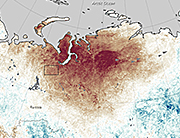An enduring high-pressure weather system over the Russian Arctic has led to a prolonged heat wave, creating conditions for another surge in wildfires a year after a particularly extreme wildfire season. NASA scientists say that a so-called “blocking high” system — in which rain-bearing systems are blocked from moving west to east — has caused temperatures to reach 90 degrees F (32 degrees C) in the northern city of Norlisk, where daily highs in July typically average 61 degrees F (16 degrees C). Using satellite data, NASA produced a map that vividly depicts the land surface temperature anomalies in the region during the week of July 20-27, with temperatures soaring as high as 37 degrees F above normal. A separate satellite image shows smoke billowing from several fires burning in one of the areas, in the Khanty-Mansiyskiy and Yamal-Nenetskiy districts. According to scientists, the Siberian fires are burning in areas far north of where summer wildfires typically occur.
Click to enlarge
NASA
Temperature anomalies in Russian Arctic, July 20-27